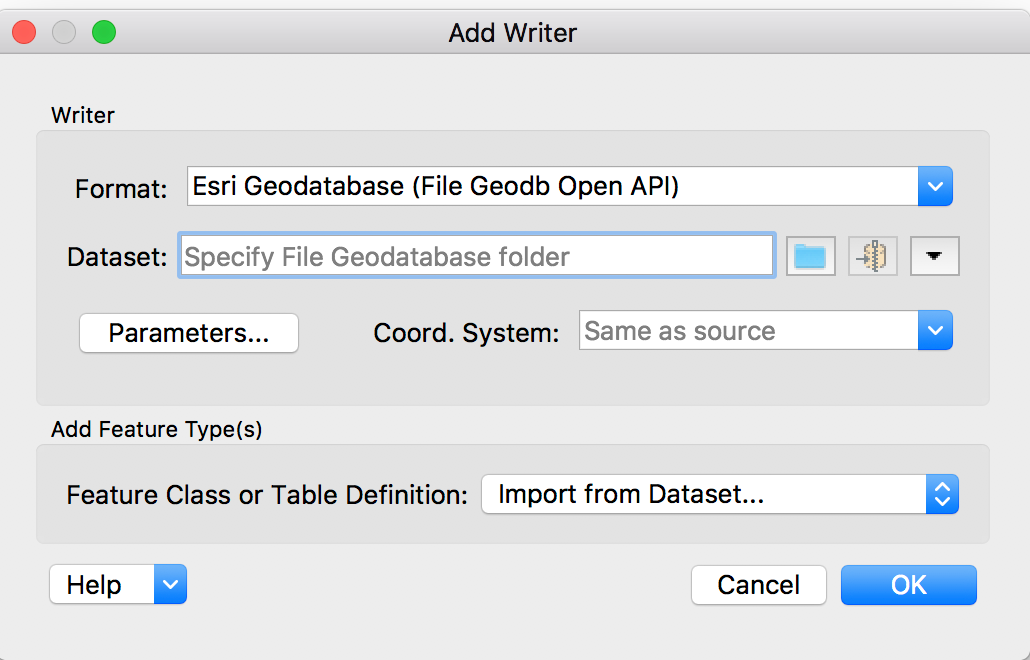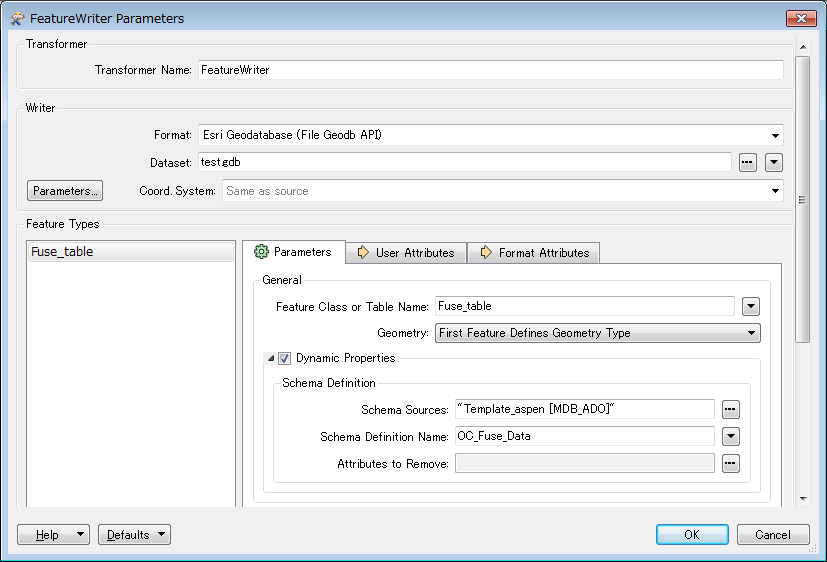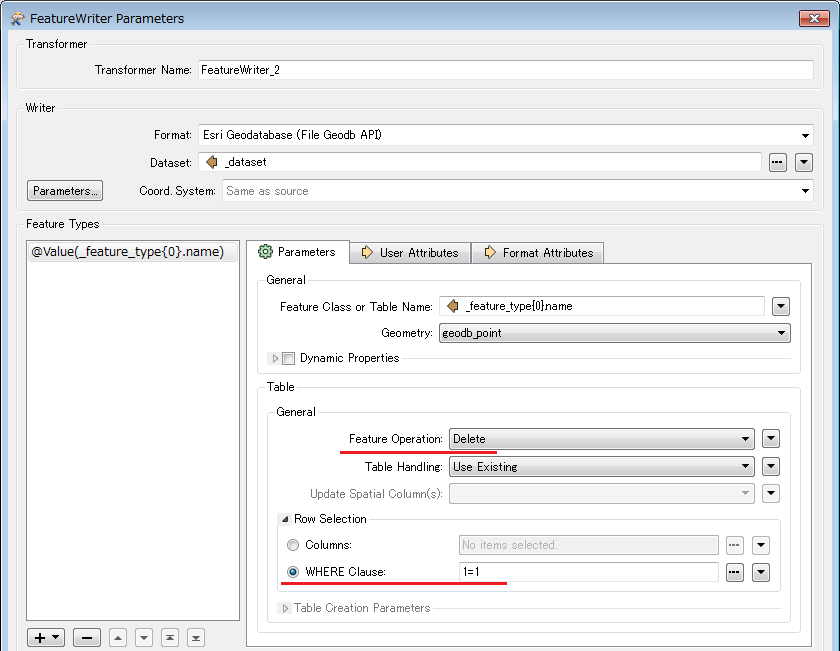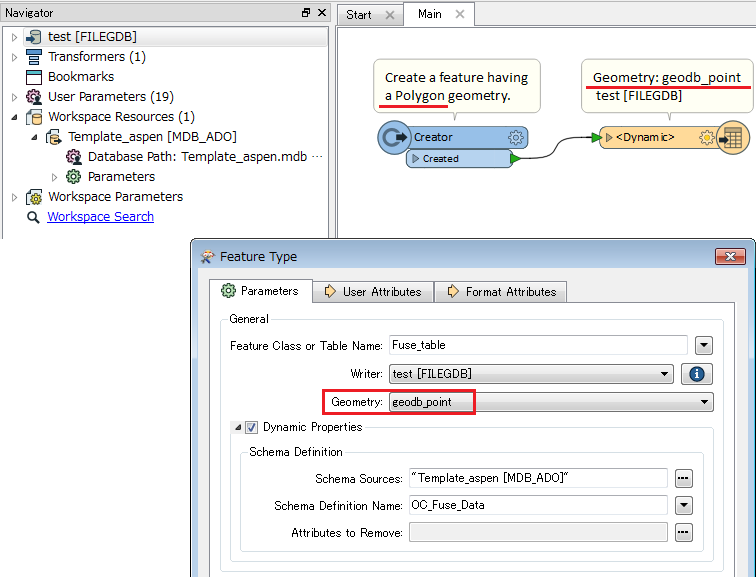Hi everybody,
I have a .mdb emtpy fields. Now, I want to convert to .Gdb (point format).
I use read .mdb and writer .gdb but I don't get point file in Gdb. Could you tell me why? Thank you
I attached my workspace in the bellow:
Hi everybody,
I have a .mdb emtpy fields. Now, I want to convert to .Gdb (point format).
I use read .mdb and writer .gdb but I don't get point file in Gdb. Could you tell me why? Thank you
I attached my workspace in the bellow:
Are you sure there's data in the database? (there isn't in the template you attached)
Are you sure there's data in the database? (there isn't in the template you attached)
If you have an MDB with a table structure you want to copy to a GDB you can add a new writer (GDB) and specify that you want to import the table definition from another dataset:

However, while this works, I generally prefer to set things up when I have some actual source data to work with. Or, since you're setting up the writer from scratch, just do that manually in FME (that's one of the other options when you're adding a writer)
If you have an MDB with a table structure you want to copy to a GDB you can add a new writer (GDB) and specify that you want to import the table definition from another dataset:

However, while this works, I generally prefer to set things up when I have some actual source data to work with. Or, since you're setting up the writer from scratch, just do that manually in FME (that's one of the other options when you're adding a writer)
In my case, I want to keep table structure as .mdb, and I will create point in .Gdb. So I can't use the way import table from other dataset :).
In my case, I want to keep table structure as .mdb, and I will create point in .Gdb. So I can't use the way import table from other dataset :).
And if it does complain about that, just add one record. The contents doesn't matter, since only the structure is copied.
And if it does complain about that, just add one record. The contents doesn't matter, since only the structure is copied.
Hi @hoa_le, as @redgeographics mentioned, at least a single feature is required to be written to create a new dataset/feature type. Fortunately, the File Geodatabase format supports DELETE operation, so you can write a feature temporarily into a feature class with a FeatureWriter then delete every feature from the feature class with another FeatureWriter. In the first FeatureWriter, the schema of the feature class can be configured dynamically based on the MDB table schema.
Firstry add the MDB reader as a Workspace Resource to the workspace (Workbench Menu: Readers > Add Reader as Resource), then create the workflow like these screenshots.


Hi @hoa_le, as @redgeographics mentioned, at least a single feature is required to be written to create a new dataset/feature type. Fortunately, the File Geodatabase format supports DELETE operation, so you can write a feature temporarily into a feature class with a FeatureWriter then delete every feature from the feature class with another FeatureWriter. In the first FeatureWriter, the schema of the feature class can be configured dynamically based on the MDB table schema.
Firstry add the MDB reader as a Workspace Resource to the workspace (Workbench Menu: Readers > Add Reader as Resource), then create the workflow like these screenshots.


In your case, the NoFeaturesTester from Hub might be helpful.
Hi @hoa_le, as @redgeographics mentioned, at least a single feature is required to be written to create a new dataset/feature type. Fortunately, the File Geodatabase format supports DELETE operation, so you can write a feature temporarily into a feature class with a FeatureWriter then delete every feature from the feature class with another FeatureWriter. In the first FeatureWriter, the schema of the feature class can be configured dynamically based on the MDB table schema.
Firstry add the MDB reader as a Workspace Resource to the workspace (Workbench Menu: Readers > Add Reader as Resource), then create the workflow like these screenshots.


Simpler and works as expected in FME 2017, but I don't know if it is guaranteed that this method works in the future as well.

Hi @hoa_le, as @redgeographics mentioned, at least a single feature is required to be written to create a new dataset/feature type. Fortunately, the File Geodatabase format supports DELETE operation, so you can write a feature temporarily into a feature class with a FeatureWriter then delete every feature from the feature class with another FeatureWriter. In the first FeatureWriter, the schema of the feature class can be configured dynamically based on the MDB table schema.
Firstry add the MDB reader as a Workspace Resource to the workspace (Workbench Menu: Readers > Add Reader as Resource), then create the workflow like these screenshots.


Thank you so much. But I have a quesiton, the output file is not point type, it's only table in in Gdb. My target is point. I attached my workspace. create-gdb-from-tbl.fmw

Enter your username or e-mail address. We'll send you an e-mail with instructions to reset your password.